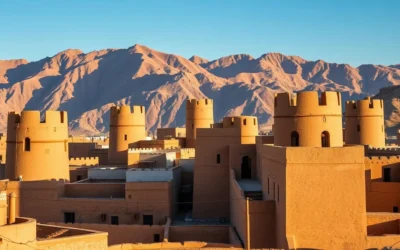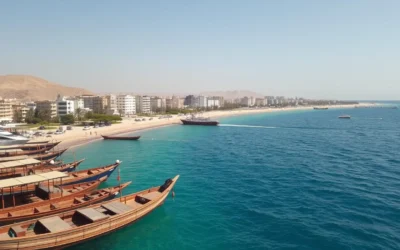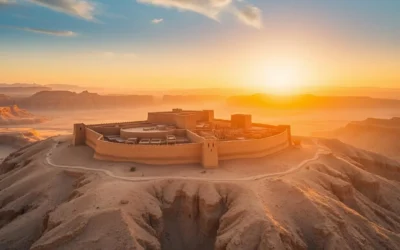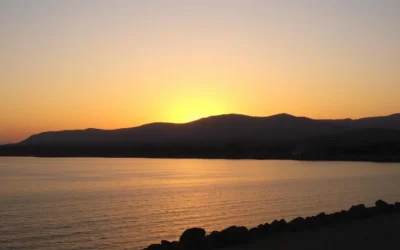Did you know Marib was once the capital of the ancient Kingdom of Saba, home to the legendary Queen of Sheba? Today, its archaeological treasures lie scattered across a desert landscape unchanged for millennia, offering visitors a rare glimpse into one of humanity’s earliest civilizations. As one of Yemen’s most historically significant cities, Marib holds secrets dating back over 3,000 years, waiting to be discovered by intrepid travelers.
Getting There & Planning Your Journey
Reaching Marib requires careful planning due to Yemen’s current situation. The city is located approximately 170 km (106 miles) east of Sana’a, Yemen’s capital. Most travelers reach Marib via organized tours with local operators who can arrange necessary permits and transportation.
Due to the ongoing situation in Yemen, it’s essential to work with experienced local guides and tour operators who understand the current conditions and can ensure your safety. Most visitors access Marib as part of a larger Yemen tour package, which typically includes transportation, accommodation, and guided visits to the main attractions.
Required Documents
To visit Yemen, you’ll need:
- Valid passport with at least 6 months validity
- Yemeni visa (usually arranged through a local tour operator)
- Travel insurance with coverage for Yemen
- Letter of invitation from a Yemeni sponsor (typically your tour operator)
Best Time to Visit Marib
Marib’s desert climate means extreme temperature variations throughout the year. Choosing the right time to visit can make your experience much more comfortable.
| Season | Months | Temperature | Recommendation |
| Winter (Best) | November-February | 18-25°C (64-77°F) | Ideal weather for sightseeing |
| Spring | March-April | 22-32°C (72-90°F) | Good conditions, warming up |
| Summer (Avoid) | May-September | 35-40°C (95-104°F) | Extremely hot, not recommended |
| Fall | October | 25-30°C (77-86°F) | Temperatures beginning to cool |
The winter months (November through February) offer the most pleasant temperatures for exploring Marib’s outdoor archaeological sites. During this period, daytime temperatures typically range from 18-25°C (64-77°F), making it comfortable for walking and sightseeing.
Travel Tip: Even during the cooler months, the sun can be intense in Marib. Always bring sun protection, including a hat, sunglasses, and sunscreen, and carry plenty of water when visiting archaeological sites.
Getting Around Locally

Moving around Marib and visiting its historical sites requires reliable transportation. The archaeological attractions are spread across a wide area, often with considerable distances between them.
Transportation Options
Guided Tours
The safest and most practical option is to arrange transportation through your tour operator. Most organized tours include a 4×4 vehicle with a driver who knows the area well and can navigate between sites efficiently.
Rental Vehicles
For those with more experience in the region, renting a vehicle is possible but should be arranged through reliable local contacts. A 4×4 vehicle is essential for navigating the terrain around archaeological sites.
Local Guidance: Due to the remote nature of some sites and current security considerations, it’s highly recommended to have a local guide accompany you, even if you have your own transportation. They can provide valuable historical context and ensure you visit sites safely.
Where to Stay in Marib

Accommodation options in Marib are limited but sufficient for travelers. Most visitors stay in the modern part of the city, where basic but comfortable hotels are available. Due to the current situation, it’s advisable to have your accommodation pre-arranged through your tour operator.
Accommodation Types
Business Hotels
Marib has several business-oriented hotels that cater to both local and international visitors. These typically offer air-conditioned rooms, private bathrooms, and basic amenities.
Guesthouses
Some smaller, family-run guesthouses provide a more authentic experience with traditional Yemeni hospitality. These often include home-cooked meals.
Tour Accommodations
Many tour operators have arrangements with specific hotels or guesthouses that meet their standards for international visitors.
Important Note: Electricity and water supply can be inconsistent in Marib. Many hotels have generators, but it’s advisable to be prepared for occasional outages. Bringing a portable power bank for charging devices is recommended.
Dining & Local Cuisine

Yemeni cuisine is rich in flavors and traditions, with dishes that have been perfected over centuries. In Marib, you’ll find authentic local food that reflects the region’s heritage and agricultural background.
Must-Try Dishes
Saltah
Yemen’s national dish is a meat stew served in a stone bowl, topped with fenugreek foam (hilbeh) and eaten with flatbread. It’s typically served for lunch and is a hearty, flavorful meal.
Mandi
A traditional dish of meat and rice cooked in an underground oven, giving it a distinctive smoky flavor. Marib is known for excellent mandi, often made with locally raised lamb.
Bint Al-Sahn
A layered honey cake that’s a popular dessert throughout Yemen. The flaky pastry is drizzled with honey and nigella seeds for a sweet finish to your meal.
Yemeni Coffee
Coffee originated in this region, and Yemeni coffee has a rich, distinctive flavor. It’s often served with cardamom and other spices.
Where to Eat
Most restaurants in Marib are simple establishments catering to locals. Your guide can recommend suitable places based on your preferences. Many visitors enjoy meals at their accommodation, where food is prepared with travelers’ tastes and hygiene standards in mind.
Dining Tip: Meals in Yemen are traditionally eaten with the right hand, using bread to scoop up food. However, utensils are usually available for tourists. It’s polite to wash your hands before and after eating.
Top Attractions & Sightseeing in Marib Yemen

Marib’s rich history as the capital of the ancient Sabaean Kingdom has left it with remarkable archaeological sites that attract history enthusiasts from around the world. Here are the must-visit attractions that showcase the city’s fascinating past.
Ancient Marib Dam
Dating back to the 8th century BC, the Marib Dam was an engineering marvel of the ancient world and the backbone of the Sabaean kingdom’s agricultural prosperity. Though much of the original structure has been lost to time, the remaining ruins are impressive and give insight into the advanced engineering capabilities of the Sabaean civilization.

Location: About 10 km (6 miles) southwest of modern Marib city
Visiting Tips: Early morning or late afternoon visits provide the best light for photography and more comfortable temperatures. The site requires walking over uneven terrain, so comfortable footwear is essential.
Awwam Temple (Mahram Bilqis)
Also known as the Temple of the Moon God, this massive oval-shaped temple complex was dedicated to the moon god Almaqah and dates back to the 7th century BC. It features impressive columns and intricate carvings that have survived for millennia.

Location: Approximately 7 km (4.3 miles) east of modern Marib
Historical Significance: This temple was one of the most important religious sites in the Arabian Peninsula during the Sabaean period and is associated with the legendary Queen of Sheba.
Barran Temple
Another important religious site from the Sabaean era, the Barran Temple features impressive columns and was dedicated to Almaqah, the moon god. Its architectural elements show the sophisticated building techniques of the ancient Sabaeans.

Location: About 5 km (3 miles) from modern Marib
Visiting Tips: The site is often less crowded than the Marib Dam, allowing for a more contemplative experience of ancient Sabaean architecture.
Museums & Cultural Spots

Marib Museum
The Marib Museum houses an impressive collection of artifacts from the region’s rich history, including items from the Sabaean period. The museum provides valuable context for understanding the archaeological sites you’ll visit in the area.
Exhibits: The museum displays include ancient inscriptions, pottery, statues, and everyday items that offer insights into life during the Sabaean kingdom. Many artifacts were recovered from excavations at the nearby archaeological sites.
Visiting Information: Opening hours can vary, so it’s best to check with your guide or hotel. Photography may be restricted in certain areas of the museum.
Old Marib
The remains of the ancient city of Marib provide a glimpse into one of the oldest continuously inhabited settlements in the world. While much of Old Marib is now uninhabited, walking through its narrow streets and observing the traditional mud-brick architecture offers a connection to the past.

Historical Significance: Old Marib dates back approximately 3,000 years and was once a thriving center of the incense trade that connected Arabia to the Mediterranean world.
Local Markets
Marib’s markets offer a glimpse into contemporary Yemeni life and culture. The main souq (market) sells everything from food and spices to traditional crafts and everyday items.

Shopping Tips: Local handicrafts, including jambiya (traditional daggers), textiles, and honey from the Hadhramaut region make excellent souvenirs. Bargaining is expected in the markets, but always do so respectfully.
Outdoor Experiences

Desert Excursions
The landscapes surrounding Marib offer opportunities for desert adventures. The edge of the Rub’ al Khali (Empty Quarter), one of the world’s largest sand deserts, is accessible from Marib and provides a stunning backdrop for exploration.
Activities: Depending on your interests and the security situation, activities might include:
- Camel rides across the desert landscape
- Visits to Bedouin camps to learn about traditional desert life
- Photography expeditions to capture the dramatic desert scenery
- Stargazing in the clear desert night sky
Safety Note: Desert excursions should only be undertaken with experienced local guides who know the terrain and current security conditions. Always carry plenty of water and sun protection.
Wadi Exploration
The wadis (dry riverbeds) around Marib occasionally fill with water after rains, creating temporary oases. These areas offer interesting geological features and sometimes support surprising amounts of vegetation and wildlife.

Best Time: If you’re interested in seeing wadis with water, the best time to visit would be shortly after the rainy season (typically March-April or July-August), though this can vary year to year.
Safety, Etiquette & Local Customs

Safety Considerations
Yemen’s current situation requires travelers to be particularly cautious. While Marib has been more stable than some other parts of the country, conditions can change rapidly.
Important: Before planning a trip to Marib or anywhere in Yemen, check your government’s travel advisories and work with reputable local tour operators who can provide up-to-date safety information. Most countries currently advise against all travel to Yemen due to security concerns.
If you do visit, take these precautions:
- Travel with experienced local guides at all times
- Register with your embassy if possible
- Maintain communication with your tour operator
- Purchase comprehensive travel insurance that specifically covers Yemen
- Avoid photography of military or security installations
Cultural Etiquette
Yemen is a conservative Muslim country with strong traditional values. Respecting local customs will enhance your experience and show consideration for your hosts.
Dress Code
Both men and women should dress modestly. Men should wear long pants and shirts that cover the shoulders. Women should wear loose-fitting clothes that cover arms, legs, and hair (a headscarf is recommended).
Social Interactions
Greet people with “As-salaam alaikum” (peace be upon you). Men should not offer to shake hands with women unless she extends her hand first. Remove shoes before entering homes or mosques.
Photography
Always ask permission before photographing people, especially women. Avoid photographing military checkpoints, government buildings, or other sensitive areas.
Religious Customs
Respect prayer times and religious practices. During Ramadan, avoid eating, drinking, or smoking in public during daylight hours.
Practical Travel Tips

Essential Items to Pack
- Modest clothing suitable for hot weather and conservative culture
- Headscarf for women
- Sturdy walking shoes for archaeological sites
- High SPF sunscreen, sunglasses, and a wide-brimmed hat
- Reusable water bottle and water purification tablets
- First aid kit with personal medications
- Power bank for charging devices (electricity can be unreliable)
- Cash in US dollars (credit cards are rarely accepted)
Communication
Arabic is the official language in Yemen. While some people in the tourism industry may speak basic English, having a guide who can translate is essential. Learning a few Arabic phrases will be appreciated by locals.
Internet access and mobile phone coverage in Marib can be limited and unreliable. Consider purchasing a local SIM card if you need to stay connected, though service may still be intermittent.
Money Matters
The Yemeni Rial (YER) is the local currency, but US dollars are widely accepted and often preferred for larger transactions. There are few functioning ATMs, so bring sufficient cash for your entire stay. Exchange rates can vary significantly, so it’s worth comparing rates if possible.
Tipping Guide: Tipping is appreciated but not always expected. For guides and drivers who provide good service, 10-15% is appropriate. In restaurants, 5-10% is sufficient if service is not already included.
Experience the Ancient Wonders of Marib

Marib isn’t just a destination—it’s a journey through time. From whispering desert winds to echoes of ancient civilizations, this Yemeni gem promises an adventure unlike any other. The archaeological treasures of the Sabaean kingdom, set against the backdrop of Yemen’s dramatic landscapes, offer a rare glimpse into one of humanity’s earliest advanced civilizations.
While traveling to Marib presents challenges due to Yemen’s current situation, those who make the journey are rewarded with extraordinary historical experiences far from the beaten tourist path. With proper planning, local guidance, and respect for safety considerations, Marib reveals its secrets to intrepid travelers willing to explore this remarkable corner of the Arabian Peninsula.
Are you ready to write your own chapter in Marib’s 3,000-year story?
The above is subject to change.
Check back often to TRAVEL.COM for the latest travel tips and deals.






